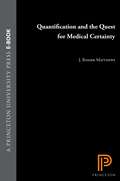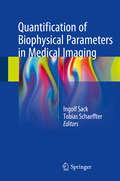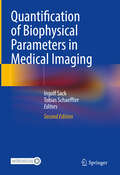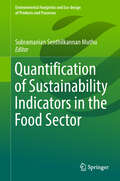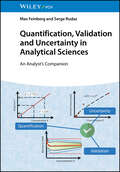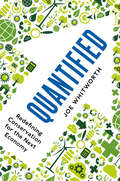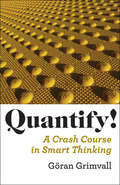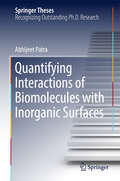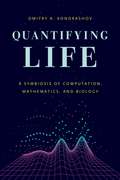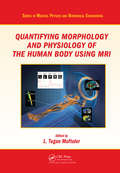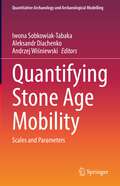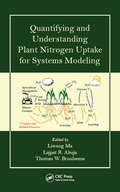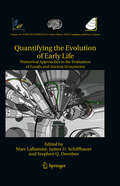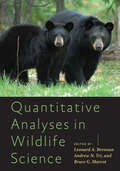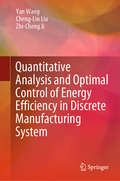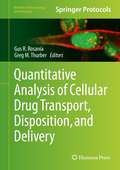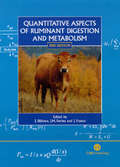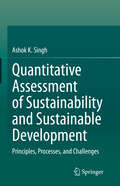- Table View
- List View
Quantification and the Quest for Medical Certainty
by J. Rosser MathewsSince its inception in World War II, the clinical trial has evolved into a standard procedure in determining therapeutic efficacy in many Western industrial democracies. Its features include a "control" group of patients that do not receive the experimental treatment, the random allocation of patients to either the experimental or control group, and the use of blind assessment so that the researchers do not know which patients are in either group. Even though it has been only within the past generation that the clinical trial has moved to the forefront of medical research, comparative statistics in a therapeutic context has a much longer history. From that history J. Rosser Matthews chooses to discuss three crucial debates: that among clinicians before the Parisian Academy of Medicine in 1837, the debate in the German physiological literature during the 1850s, and, in the early twentieth century, the debate over the bacteriologist's diagnostic technique involving the "opsonic index."Matthews demonstrates that despite the very real differences separating clinician, physiologist, and bacteriologist, they all shared an antipathy toward the methods of the statistician. Since they viewed medical judgment as a form of "tacit knowledge," they downplayed the concerns of the medical statistician who was attempting to make medical inference into something explicit and quantitative. Only when "medical decision-making" moved from the cloistered confines of professional medical expertise into the arena of open political debate could the medical statistician (and the clinical trial) gain the upper hand.
Quantification of Biophysical Parameters in Medical Imaging
by Ingolf Sack Tobias SchaeffterThis book provides a selection of essential knowledge on the image-based quantification of biophysical parameters for the purpose of clinical diagnosis. The authors regard clinical imaging scanners as physical measurement systems capable of quantifying intrinsic parameters for depiction of the constitution and biophysical properties of in vivo tissue. On the one hand, this approach supports the development of new methods of imaging highly reproducible, system-independent, and quantitative biomarkers, and these methods receive detailed attention in the book. On the other hand, the reader will also gain a deeper understanding of how physical tissue properties interact with the generation of signals in medical imaging, opening new windows on the intricate and fascinating relationship between the structure and function of living tissues. The book will be of interest to all who recognize the limitations of basing clinical diagnosis primarily on visual inspection of images and who wish to learn more about the diagnostic potential of quantitative and biophysics-based medical imaging markers and the challenges that the paucity of such markers poses for next-generation imaging technologies.
Quantification of Biophysical Parameters in Medical Imaging
by Ingolf Sack Tobias SchaeffterThe second edition of this book offers six new chapters covering the latest developments in quantitative medical imaging, including artificial intelligence, MRI mapping, sonography, elastography and cardiac CT. All the other existing chapters have been updated and expanded, many with new text and figures, to reflect the rapid translation and advancement of technology in this exciting area of biomedical research. This updated edition presents fundamental knowledge on the imaging quantification of biophysical parameters for clinical diagnostic purposes. Clinical imaging scanners are considered by the authors as physical measurement systems capable of quantifying intrinsic parameters for the representation of the constitution and biophysical properties of tissues in vivo. In one respect, this approach fosters the development of new imaging methods for highly reproducible, system-independent, and quantitative biomarkers. These methods are greatly detailed in the book. Alternatively, this new edition equips the reader with a better understanding of how the physical properties of tissues interact with signal generation in medical imaging, opening up new insights into the complex and fascinating relationship between structure and function in living tissues. This updated edition is of interest to all those who recognize the limitations of clinical diagnosis based primarily on visual inspection of images, and who wish to learn more about the diagnostic potential of quantitative, biophysically-based medical imaging markers, as well as the challenges posed by the scarcity of such markers for next-generation imaging technologies.
Quantification of Contrast Kinetics in Clinical Imaging (SpringerBriefs in Applied Sciences and Technology)
by Osama I. Soliman Folkert J. ten Cate Massimo Mischi Simona Turco Hessel Wijkstra Ivo SchootsThis book provides a comprehensive survey of the pharmacokinetic models used for the quantitative interpretation of contrast-enhanced imaging. It discusses all the available imaging technologies and the problems related to the calibration of the imaging system and accuracy of the estimated physiological parameters. Enhancing imaging modalities using contrast agents has opened up new opportunities for going beyond morphological information and enabling minimally invasive assessment of tissue and organ functionality down to the molecular level. In combination with mathematical modeling of the contrast agent kinetics, contrast- enhanced imaging has the potential to provide clinically valuable additional information by estimating quantitative physiological parameters. The book presents the broad spectrum of diagnostic possibilities provided by quantitative contrast-enhanced imaging, with a particular focus on cardiology and oncology, as well as novel developments in the area of quantitative molecular imaging along with their potential clinical applications. Given the variety of available techniques, the choice of the appropriate imaging modality and the most suitable pharmacokinetic model is often challenging. As such, the book provides a valuable technical guide for researchers, clinical scientists, and experts in the field who wish to better understand and properly apply tracer-kinetic modeling for quantitative contrast-enhanced imaging.
Quantification of Sustainability Indicators in the Food Sector (Environmental Footprints And Eco-design Of Products And Processes)
by Subramanian Senthilkannan MuthuThis book highlights various methods of quantifying sustainability indicators in the food sector, highlighting the environmental indicators in the meat chain and agri-food wastes from a bio-refinery perspective. Numerous sustainability indicators that encompass all three pillars – economic, environmental and social areas – as well as individual and joint indicators (e.g. environmental and social) have been developed and quantified to date. Some of these indicators can be utilised for any industrial sector, while others are sector-specific. Behind each indicator developed, there is a unique scientific model, method or assessment technique. This book enumerates these indicators, providing details such as the concept, development methodology, assessment technique, and applications, mainly in the food industry.
Quantification, Validation and Uncertainty in Analytical Sciences: An Analyst's Companion
by Max Feinberg Serge RudazQuantification, Validation and Uncertainty in Analytical Sciences Companion guide explaining all processes in measuring uncertainty in quantitative analytical results Quantification, Validation and Uncertainty in Analytical Sciences provides basic and expert knowledge by building on the sequence of operations starting from the quantification in analytical sciences by defining the analyte and linking it to the calibration function. Proposing a comprehensive approach to MU (Measurement Uncertainty) estimation, it empowers the reader to apply Method Accuracy Profile (MAP) efficiently as a statistical tool in measuring uncertainty. The text elucidates several examples and template worksheets explaining the theoretical aspects of the procedure and includes novel method validation procedures that can accurately estimate the data obtained in measurements. It also enables the reader to provide practical insights to improve decision making by accurately evaluating and comparing different analytical methods. Brings together an interdisciplinary approach with statistical tools and algorithms applied in analytical chemistry and written by two international experts with long-standing experience in the field of Analytical measurements and Uncertainty, Quantification, Validation and Uncertainty in Analytical Sciences includes information on: The know-how of methods in an analytical laboratory, effective usage of a spurious measurement and methods to estimate errors. Quantification, calibration, precision, trueness, MAP addons, estimating MU for analytical sciences, and uncertainty functionsEmploying measurement uncertainty, sampling uncertainty, quantification limits, and sample conformity assessmentDecision making, uncertainty and standard addition method, and accuracy profile for method comparison Quantification, Validation and Uncertainty in Analytical Sciences is an ideal resource for every individual quantifying or studying analytes. With several chapters dedicated to MU’s practical use in decision making demonstrating its advantages, the book is primarily intended for professional analysts, although researchers and students will also find it of interest.
Quantified: Redefining Conservation for the Next Economy
by Joe S. WhitworthGoogle, Apple, Amazon, Uber: companies like these have come to embody innovation, efficiency, and success. How often is the environmental movement characterized in the same terms? Sadly, conservation is frequently seen as a losing battle, waged by well-meaning, but ultimately ineffective idealists. Joe Whitworth argues it doesn't have to be this way. In fact, it can't be this way if we are to maintain our economy, let alone our health or the planet's. In Quantified, Whitworth draws lessons from the world's most tech-savvy, high-impact organizations to show how we can make real gains for the environment. The principles of his approach, dubbed quantified conservation, will be familiar to any thriving entrepreneur: situational awareness, bold outcomes, innovation and technology, data and analytics, and gain-focused investment. This no-nonsense strategy builds on the inspirational environmental work begun in the 1970s, while recognizing that the next economy will demand new solutions. As President of The Freshwater Trust, Whitworth has put quantified conservation into practice, pioneering the model of a "do-tank" that is dramatically changing how rivers can get restored across the United States. The stories in Quantified highlight the most precious of resources--water--but they apply to any environmental effort. Whether in the realm of policy, agriculture, business, or philanthropy, Whitworth is charting a new course for conservation.
Quantify!: A Crash Course in Smart Thinking
by Göran GrimvallGöran Grimvall is determined to help mere mortals understand how scientists get to the kernel of perplexing problems. Entertaining and enlightening, his latest book uses examples from sports, literature, and nature—as well as from the varied worlds of science—to illustrate how scientists make sense of and explain the world around us. Grimvall's fun-to-read essays and easy-to-follow examples detail how order-of-magnitude estimation, extreme cases, dimensional analysis, and other modeling methods work. They also reveal how nonscientists absorb these concepts and use them at home, school, and work. Grimvall's simple, elegant explanations will help you tap into your inner scientist. Read this book and enjoy your own "Aha!" moment.
Quantify!: A Crash Course in Smart Thinking
by Göran GrimvallEssays and examples that reveal how scientists figure things out: “An excellent piece of work with lots of fascinating information.” —Brian Clegg, Popular ScienceGöran Grimvall is determined to help mere mortals understand how scientists get to the kernel of perplexing problems. Entertaining and enlightening, his latest book uses examples from sports, literature, and nature—as well as from the varied worlds of science—to illustrate how scientists make sense of and explain the world around us.Grimvall’s fun-to-read essays and easy-to-follow examples detail how order-of-magnitude estimation, extreme cases, dimensional analysis, and other modeling methods work. They also reveal how nonscientists absorb these concepts and use them at home, school, and work.These simple, elegant explanations will help you tap into your inner scientist. Read this book and enjoy your own “Aha!” moment.“A wonderful read for everyone, emphasizing how scientists and engineers tend to think about examples from daily life that are expressed by numbers . . . Highly recommended.” —Choice
Quantifying Functional Biodiversity
by Fernando Casanoves Julio Di Rienzo Laura PlaThis book synthesizes current methods used to quantify functional diversity, providing step-by-step examples for defining functional groups and estimating functional indices. The authors show how to compare communities, and how to analyze changes of diversity along environmental gradients, using real-life examples throughout. One section of the book demonstrates the selection of traits, and the standardization and characterization of ecosystem data. Another section presents methods used to quantify functional diversity, shows how to relate functional diversity with environmental variables and how to connect these to ecosystem services. The concluding section introduces FDiversity, a free program developed by the authors. The reader is guided through every step from software installation and basic functions, to sample and database design, to graphical projection methods, employing case study data to illustrate key concepts.
Quantifying Interactions of Biomolecules with Inorganic Surfaces
by Abhijeet PatraThis thesis demonstrates the adaptation of existing techniques and principles towards enabling clean and precise measurements of biomolecules interacting with inorganic surfaces. In particular, it includes real-time measurement of serum proteins interacting with engineered nanomaterial. Making meaningful and unambiguous measurements has been an evolving problem in the field of biology and its various allied domains, primarily due to the complex nature of experiments and the large number of possible interferants. The subsequent quantification of interactions between biomolecules and inorganic surfaces solves pressing problems in the rapidly developing fields of lipidomics and nanomedicine.
Quantifying Life: A Symbiosis of Computation, Mathematics, and Biology
by Dmitry A. KondrashovSince the time of Isaac Newton, physicists have used mathematics to describe the behavior of matter of all sizes, from subatomic particles to galaxies. In the past three decades, as advances in molecular biology have produced an avalanche of data, computational and mathematical techniques have also become necessary tools in the arsenal of biologists. But while quantitative approaches are now providing fundamental insights into biological systems, the college curriculum for biologists has not caught up, and most biology majors are never exposed to the computational and probabilistic mathematical approaches that dominate in biological research. With Quantifying Life, Dmitry A. Kondrashov offers an accessible introduction to the breadth of mathematical modeling used in biology today. Assuming only a foundation in high school mathematics, Quantifying Life takes an innovative computational approach to developing mathematical skills and intuition. Through lessons illustrated with copious examples, mathematical and programming exercises, literature discussion questions, and computational projects of various degrees of difficulty, students build and analyze models based on current research papers and learn to implement them in the R programming language. This interplay of mathematical ideas, systematically developed programming skills, and a broad selection of biological research topics makes Quantifying Life an invaluable guide for seasoned life scientists and the next generation of biologists alike.
Quantifying Morphology and Physiology of the Human Body Using MRI (Series in Medical Physics and Biomedical Engineering)
by L. Tugan MuftulerIn the medical imaging field, clinicians and researchers are increasingly moving from the qualitative assessment of printed images to the quantitative evaluation of digital images since the quantitative techniques often improve diagnostic accuracy and complement clinical assessments by providing objective criteria. Despite this growing interest, th
Quantifying Quality of Life: Incorporating Daily Life into Medicine (Health Informatics)
by Katarzyna Wac Sharon WulfovichThis open access book presents the rise of technology-enabled methods and tools for objective, quantitative assessment of Quality of Life (QoL), while following the WHOQOL model. It is an in-depth resource describing and examining state-of-the-art, minimally obtrusive, ubiquitous technologies. Highlighting the required factors for adoption and scaling of technology-enabled methods and tools for QoL assessment, it also describes how these technologies can be leveraged for behavior change, disease prevention, health management and long-term QoL enhancement in populations at large. Quantifying Quality of Life: Incorporating Daily Life into Medicine fills a gap in the field of QoL by providing assessment methods, techniques and tools. These assessments differ from the current methods that are now mostly infrequent, subjective, qualitative, memory-based, context-poor and sparse. Therefore, it is an ideal resource for physicians, physicians in training, software and hardware developers, computer scientists, data scientists, behavioural scientists, entrepreneurs, healthcare leaders and administrators who are seeking an up-to-date resource on this subject.
Quantifying Stone Age Mobility: Scales and Parameters (Quantitative Archaeology and Archaeological Modelling)
by Iwona Sobkowiak-Tabaka Aleksandr Diachenko Andrzej WiśniewskiThis book focuses on the analysis of different scales of mobility and addresses parameters and proxies of population movement aiming at the formation of a ‘ground’ for the further development of quantitative approaches. In order to do so, the volume explores wide scale mobility (environmental contexts and cross-cultural trends), seasonal mobility of Paleolithic and Mesolithic hunter-gatherers, and migration, niche construction, utilitarian and non- utilitarian factors of mobility.Chapters in the volume include case studies from across Europe and Asia. The editors’ introduction addresses the current state of mobility discourse in archaeology. The chapters address questions related to parameters used to describe different factors of movement and examines correlations between parameters describing environmental diversity, demography, and the values representing spatial movement. This volume is of interest to students and researchers of mobility of human beings in the past.
Quantifying and Understanding Plant Nitrogen Uptake for Systems Modeling
by Liwang Ma Lajpat R. Ahuja Tom BruulsemaDiscusses New Advancements to Improve Existing Simulations of Plant NitrogenWritten by research pioneers and leading scientists in the area of agricultural systems, Quantifying and Understanding Plant Nitrogen Uptake for Systems Modeling comprehensively covers plant N uptake in agricultural system models, especially for building soil-plant system m
Quantifying the Evolution of Early Life
by James D. Schiffbauer Marc Laflamme Stephen Q. DornbosThis volume provides a detailed description of a wide range of numerical, statistical or modeling techniques and novel instrumentation separated into individual chapters written by paleontologists with expertise in the given methodology. Each chapter outlines the strengths and limitations of specific numerical or technological approaches, and ultimately applies the chosen method to a real fossil dataset or sample type. A unifying theme throughout the book is the evaluation of fossils during the prologue and epilogue of one of the most exciting events in Earth History: the Cambrian radiation.
Quantitation and Mass Spectrometric Data of Drugs and Isotopically Labeled Analogs
by Ray H. Liu Dennis V. Canfield Sheng-Meng WangThe analysis of drugs and their metabolites in biological media are now expected to routinely achieve � 20% accuracy in the ng/mL concentration level. Therefore, the availability and the selection of quality ion-pairs designating the analytes and their isotopically labeled analogs (ILAs) are important considerations in achieving the accuracy of qua
Quantitative Analyses in Wildlife Science (Wildlife Management and Conservation)
by Leonard A. Brennan, et al.An authoritative guide to quantitative methods that will help wildlife scientists improve analysis and decision-making.Over the past fifty years, wildlife science has become increasingly quantitative. But to wildlife scientists, many of whom have not been formally trained as biometricians, computer modelers, or mathematicians, the wide array of available techniques for analyzing wildlife populations and habitats can be overwhelming. This practical book aims to help students and professionals alike understand how to use quantitative methods to inform their work in the field. Covering the most widely used contemporary approaches to the analysis of wildlife populations and habitats, Quantitative Analyses in Wildlife Science is divided into five broad areas:• general statistical methods• demographic estimation• dynamic process modeling• analysis of spatially based data on animals and resources• numerical methodsAddressing a variety of topics, from population estimation and growth trend predictions to the study of migration patterns, this book presents fresh data on such pressing issues as sustainable take, control of invasives, and species reintroduction. Authored by leading researchers in wildlife science, each chapter considers the structure of data in relation to a particular analytical technique, as well as the structure of variation in those data. Providing conceptual and quantitative overviews of modern analytical methods, the techniques covered in this book also apply to conservation research and wildlife policy. Whether a quick refresher or a comprehensive introduction is called for, Quantitative Analyses in Wildlife Science is an indispensable addition to every wildlife professional's bookshelf. Contributors: William M. Block, Leonard A. Brennan, Stephen T. Buckland, Christopher C. Chizinski, Evan C. Cooch, Raymond J. Davis, Stephen J. DeMaso, Randy W. DeYoung, Jane Elith, Joseph J. Fontane, Julie A. Heinrichs, Mevin B. Hooten, Julianna M. A. Jenkins, Zachary S. Laden, Damon B. Lesmeister, Daniel Linden, Jeffrey J. Lusk, Bruce G. Marcot, David L. Miller, Michael L. Morrison, Eric Rexstad, Jamie S. Sanderlin, Joseph P. Sands, Erica F. Stuber, Chris Sutherland, Andrew N. Tri, David B. Wester, Gary C. White, Christopher K. Williams, Damon L. Williford
Quantitative Analysis and Optimal Control of Energy Efficiency in Discrete Manufacturing System
by Yan Wang Cheng-Lin Liu Zhi-Cheng JiThis book provides energy efficiency quantitative analysis and optimal methods for discrete manufacturing systems from the perspective of global optimization. In order to analyze and optimize energy efficiency for discrete manufacturing systems, it uses real-time access to energy consumption information and models of the energy consumption, and constructs an energy efficiency quantitative index system. Based on the rough set and analytic hierarchy process, it also proposes a principal component quantitative analysis and a combined energy efficiency quantitative analysis. In turn, the book addresses the design and development of quantitative analysis systems. To save energy consumption on the basis of energy efficiency analysis, it presents several optimal control strategies, including one for single-machine equipment, an integrated approach based on RWA-MOPSO, and one for production energy efficiency based on a teaching and learning optimal algorithm. Given its scope, the book offers a valuable guide for students, teachers, engineers and researchers in the field of discrete manufacturing systems.
Quantitative Analysis of Cellular Drug Transport, Disposition, and Delivery (Methods in Pharmacology and Toxicology)
by Gus R. Rosania Greg M. ThurberThis thorough book explores some of the most important methods and concepts affecting the quantitative analysis of the transport, targeting, and disposition of chemicals within cells, which in turn impact the macroscopic pharmacokinetics of chemical agents in the whole organism. The first half of the volume focuses on small organic molecules with drug-like characteristics, while the second half delves into the cellular pharmacokinetics of biologics and other macromolecules, including peptide therapeutics, cyclotides, antibodies, as well as nanoparticles, thus creating a comprehensive treatise that approaches cellular pharmacokinetics from the different perspectives of pharmaceutical scientists, chemical biologists, medicinal chemists, and protein engineers dealing with very different chemical agents spanning a wide range of sizes, physicochemical properties, and targeting mechanisms. Written for the Methods in Pharmacology and Toxicology series, chapters provide the kind of key detail and expert implementation advice that leads to excellent results in the lab. Synthetic biologists, biophysicists, and bioengineers are amongst the long list of scientists who could benefit from reading this book or from using it as a textbook. Authoritative and practical, Quantitative Analysis of Cellular Drug Transport, Disposition, and Delivery builds on a long history of drug development and the adding of quantitative methods at the cellular scale in order to inspire new approaches to drug development that are better able to take advantage of phenomena such as soluble-to-insoluble phase transitions or bispecific targeting, which could ultimately be exploited for the development of more effective drug delivery systems and therapeutic agents.
Quantitative Aspects of Ruminant Digestion and Metabolism (2nd edition)
by J. M. Forbes J. Dijkstra J. FranceA comprehensive review of the digestion and metabolism of ruminant animals. Since its publication, much new research has been conducted in the subject and knowledge has increased. This new edition includes Dr. Dijkstra as an additional editor and four completely new chapters. These cover: the gas production technique in feed evaluation; the relationship between pasture characteristics and animal performance; calorimetry; and feed processing. Other chapters have been expanded or updated as appropriate.
Quantitative Assessment of Groundwater and Surface Water Interactions in the Hailiutu River Basin, Erdos Plateau, China (IHE Delft PhD Thesis Series)
by Zhi YangThis study presents a multi-disciplinary approach for investigating the interactions between groundwater and surface water in the semi-arid Hailiutu catchment in the Erdos Plateau, Northwest China. The study consists of statistical detection of river flow regime shifts at the basin level; multiple in-situ measurements for quantifying groundwater discharges using hydraulic, hydrochemical and temperature methods at a local scale; analysis and simulation of impacts of different land use scenarios on groundwater and surface water interactions at the sub-catchment scale; and the quantification of temporal and spatial groundwater and surface water interactions with hydrochemical tracers and modelling methods at the basin scale. The study found that the river flow consists of mainly groundwater discharges at all scales. The river flow regime has been intensively altered by human activities, such as the construction of reservoirs, water diversion, groundwater exploitation, and reforestation. Water use by plants and crops consumes majority of the precipitation. Groundwater sustains vegetation growth and feeds river discharges. The water resources and ecosystem management priority should reduce evaporative water uses by promoting dry resistant plant species for vegetating sand dunes and lower irrigation demand crops for socio-economic development. Furthermore, the Hailiutu River catchment must manage the groundwater recharge for water resource conservation and the maintenance of healthy ecosystems.
Quantitative Assessment of Sustainability and Sustainable Development: Principles, Processes, and Challenges
by Ashok K. SinghThis volume discusses and analyses the use of quantitative indicators to assess sustainability across sectors, with the goal of offering readers the tools to choose and validate indicators. Sustainability (SU) and sustainable development (SD) are critical for survival of humanity, but fraught with both definitional and measurement issues. SU and SD are complex multidimensional processes exhibiting (i) social, cultural, and economic variabilities, (ii) a lack of unified definition, and (iii) conceptual vagueness. These deficiencies complicate attempts to measure the effectiveness of SU/SD efforts and make comparisons across programs and geographies difficult. This book explains, in clear terms, the causes, consequences, and assessment of SU and SD deficiencies. An indicator developed for one geographical or climate region may or may not accurately assess sustainability status of another system in different region. That is why, in spite of plenty indicators currently available, there is a need to validate existing or new indicators to assess sustainability. This book develops a database of indicators targeting different aspects of SU and SD and discusses the indicators’ elasticity, range, advantages and disadvantages. The book also provides theoretical and applied information regarding selection of indicators online and/or design new indicators. This volume is targeted toward faculty and graduate/postgraduate scholars working in research areas relevant to sustainability, especially those looking for assessment methodologies and advice on selection and validation of relevant indicators.
Quantitative Bioimaging: An Introduction to Biology, Instrumentation, Experiments, and Data Analysis for Scientists and Engineers
by Raimund J. Ober E. Sally Ward Jerry ChaoQuantitative bioimaging is a broad interdisciplinary field that exploits tools from biology, chemistry, optics, and statistical data analysis for the design and implementation of investigations of biological processes. Instead of adopting the traditional approach of focusing on just one of the component disciplines, this textbook provides a unique introduction to quantitative bioimaging that presents all of the disciplines in an integrated manner. The wide range of topics covered include basic concepts in molecular and cellular biology, relevant aspects of antibody technology, instrumentation and experimental design in fluorescence microscopy, introductory geometrical optics and diffraction theory, and parameter estimation and information theory for the analysis of stochastic data. Key Features: Comprises four parts, the first of which provides an overview of the topics that are developed from fundamental principles to more advanced levels in the other parts. Presents in the second part an in-depth introduction to the relevant background in molecular and cellular biology and in physical chemistry, which should be particularly useful for students without a formal background in these subjects. Provides in the third part a detailed treatment of microscopy techniques and optics, again starting from basic principles. Introduces in the fourth part modern statistical approaches to the determination of parameters of interest from microscopy data, in particular data generated by single molecule microscopy experiments. Uses two topics related to protein trafficking (transferrin trafficking and FcRn-mediated antibody trafficking) throughout the text to motivate and illustrate microscopy techniques. An online appendix providing the background and derivations for various mathematical results presented or used in the text is available at http://www.routledge.com/9781138598980.
